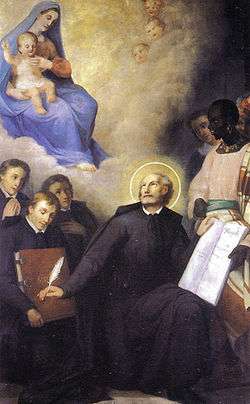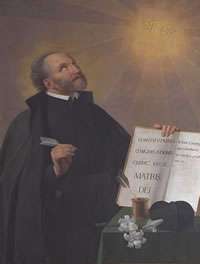John Leonardi
Giovanni Leonardi (1541 – 9 October 1609) was an Italian Roman Catholic priest and the founder of the Clerks Regular of the Mother of God of Lucca.
Giovanni Leonardi | |
|---|---|
 | |
| Priest | |
| Born | 1541 Diecimo, Lucca, Republic of Lucca |
| Died | October 9, 1609 (aged 67–68) Rome, Papal States |
| Venerated in | Roman Catholic Church |
| Beatified | 10 November 1861, Saint Peter's Basilica, Papal States by Pope Pius IX |
| Canonized | 17 April 1938, Saint Peter's Basilica, Vatican City by Pope Pius XI |
| Major shrine | Santa Maria in Campitelli, Italy |
| Feast | 9 October |
| Attributes | Cassock |
| Patronage | |
Biography
He was the youngest of seven children born to middle-class parents in Diecimo (now within the comune of Borgo a Mozzano) in the Republic of Lucca. From childhood, he sought solitude and wished to dedicate himself to prayer and meditation. At age 17, he began his ten-year study to become a certified pharmacist's assistant in Lucca. Afterward, he studied for the priesthood and was ordained in 1572. He first dedicated himself to the Christian formation of adolescents in his local Lucca parish. He also gathered a group of laymen around him to work in hospitals and prisons. In 1574 he founded a group charged to deepen Christian faith and devotion; this foundation occurred as part of the movement known as the Counter-Reformation. Leonardi worked with this group to spread devotion to the Blessed Mother and devotion to the Forty Hours as well as spreading the message of the importance of frequent reception of the Eucharist.
He became interested in the reforms instituted by the Council of Trent, and he proposed a new congregation of secular priests to convert sinners and to restore Church discipline. In 1583, his association, which became known as the Lucca Fathers, was recognized by the bishop of Lucca with the approval of Pope Gregory XIII. In 1595, his congregation was confirmed by Pope Clement VIII. He assumed the name of "Giovanni of the Mother of God" as his religious name. This foundation received approval from Pope Paul V on January 14, 1614. The pope, encouraged by the cardinal protector Giustiniani issued a papal decree approving the union of the Lucca Fathers with the Piarists of St. Joseph Calasanz. This union would last only until the beginning of 1617 when Paul V issued another decree making the Piarists their own separate congregation.
Civic leaders in Lucca opposed the establishment of a new religious order and acted to stop its formation. While ultimately ineffective, their efforts forced John Leonardi to spend most of the remainder of his life outside Lucca, with special exceptions granted by its government under the influence of the pope. Leonardi took his work to Rome where he became friends with Philip Neri. Neri became his spiritual director and held him in high regard for his qualities of firmness and judgment and entrusted him with delicate works such as the reform of the monks of Vallambrosa and the Benedictine congregation of Montevergine. In 1603, he founded along with Cardinal J. Vivès, the seminary of the Propagation of the Faith for the philosophical and theological training of missionary priests.
In 1621, his community would formally be designated Clerks Regular of the Mother of God. The final Rule of his institute was published in 1851. Two houses of the Clerks Regular of the Mother of God were opened when he died and three others were opened during the seventeenth century. He died on October 9, 1609, from the great plague, which he contracted while ministering to his brothers suffering from the influenza epidemic that was raging in Rome at the time.
He was venerated for his miracles and his religious fervor. His memory was held so high in the Holy City that Pope Leo XIII had his name placed in the Roman Martyrology and ordered the Roman clergy to celebrate his Mass and Office, an honor which is otherwise strictly limited to beatified popes.
Leonardi was beatified in 1861 and canonized in 1938 by Pope Pius XI. His liturgical feast is celebrated on 9 October. His relics lie enshrined in Santa Maria in Campitelli, Rome.
 St. Giovanni Leonardi
St. Giovanni Leonardi
References
- (October 7, 2009). On St. John Leonardi Archived 2011-09-13 at the Wayback Machine. ZENIT.
- "Encyclopédie des Saints et de la Sainteté," Hachette (in French)
- Alberto Comuzzi (1988). San Giovanni Leonardi : un nomo per tutte le vocazioni [San Juan Leonardi : un hombre apasionado por Cristo y por la Iglesia] (in Italian, French, and Spanish) (4th ed.). Cinisello Balsamo (Milan); Santiago de Chile: Edizioni Paoline. p. 167. OCLC 645374429 – via archive.is.[1]
- Bernard Baudouin (2016). Encyclopédie des saints : tous les saints de l’Église de Rome, leurs oeuvres & leurs bienfaits (in French). Bulgary: Éditions Trajectoire DL. p. 330. ISBN 978-2-84197-707-9. OCLC 1010280696 – via archive.is.
External links
| Wikimedia Commons has media related to Saint Giovanni Leonardi. |
- Referenced by Rassegna bibliografica. La Civiltà Cattolica (in Italian). 1988. p. 202. OCLC 1774680. Archived from the original on August 29, 2019.